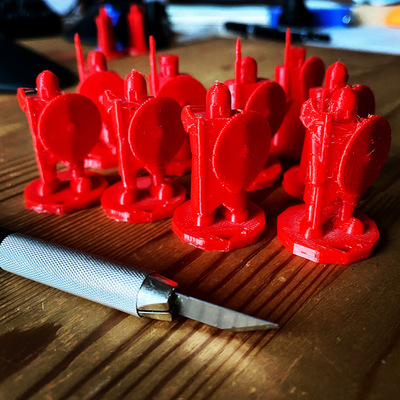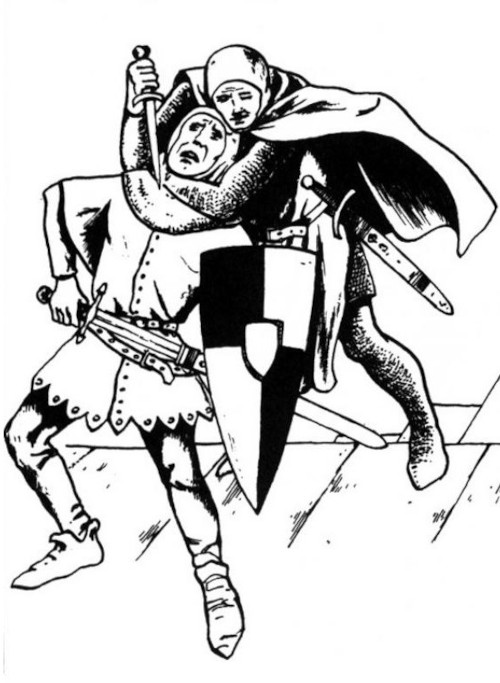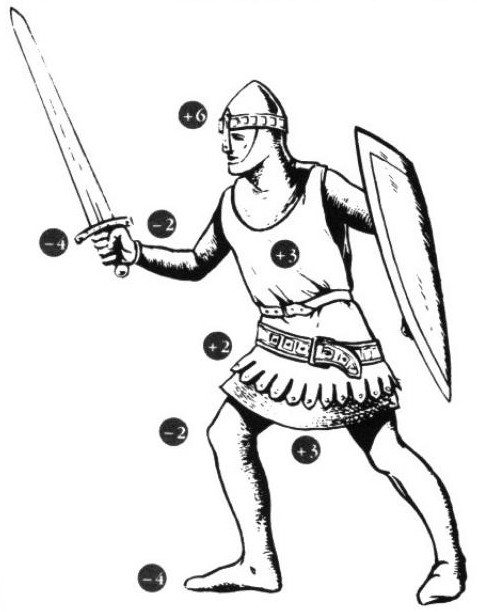
|
First Legends Combat |
| 2021-05-24 |
First Legends Combat

The combat resolution system in First Legends is interesting (at least to me). It is a 1986 French system that came as a simplification of a 1983 system named Legends.
Briefly
The time unit is called the "base" and it lasts 3 seconds.
All the actions in a base are considered as occurring simultaneously.
A character has 2 actions per base.
(But firing a shortbow takes 2 bases, firing a light crossbow takes 4 bases)
If a party achieves surprise, it is free to act for a base.
Surprise
The surprised party characters have then to roll 1d10 under their Rapidity score, those who fail their roll are surprised for a second base. On the third base, the surprise is over.
The referee is free to check the ambushing party with a roll of the Surprise skill.
Order
The base rule says that all actions taking 1 base occur simultaneously. All the results are applied, that may end in participants eliminating each other mutually.
I interpret it as all actions that end during the base are considered as occurring simultaneously.
The optional rule say that participants declare their actions in ascending Rapidity order. The melee actions are then resolved in the same order, in case of tie, longer weapons go first. Then ranged attacks are resolved, their effects being considered simultaneous, with the corollary of mutual elimination. Finally spells are triggered (unless the caster got interrupted).
Actions
Generally, a character may perform two elementary actions per base, 1 action per weapon or shield.
Thus, a character wielding 1 weapon may
- perform 1 attack and 1 feint
- perform 1 parry and 1 feint
a character wielding 1 weapon and 1 shield may
- perform 1 attack and 1 shield parry
- perform 1 weapon parry and 1 shield parry
- perform 1 weapon or shield parry and 1 feint
a character may otherwise (without weapons or shield or without using them)
- perform 2 feints
- perform 1 dodge
The dodge lets a character dive away from attacks. If successfully, they avoid any damage but they will have to stand up and reposition themselves.
optionally, a character may wield two weapons
- perform 2 attacks
- perform 1 attack and 1 parry
- perform 2 parries
a character with a ranged weapon may just fire it (may take more than 1 base)
other actions
- draw or take up a weapon (may be performed along with a feint or a dodge)
- move, when engaged in melee a character may move by 1m per base, when disengaged the character may move up to 6m per base
- disengage, other possible actions are restricted to dodge and feint, if at the end of the base the character wasn't hit, he is successfully disengaged (and may then flee)
other optional actions
- charge (atk+2), quick move to engage a foe
- disarm (atk-10)
- aim at a weapon (atk-10)
Hit Resolution
The attacker rolls 1d20 under their skill plus the attack modifier of the weapon.
For example, Gawain has 14 in Sword and uses a longsword (atk+3 par-2), should he roll a 18 or higher he misses. If he rolls a 8 he hits and his success margin is 9.
If the attack isn't countered by a parry, a feint, or entirely avoided by dodging, its damage (its success margin) is applied in full.

The defender that parries rolls 1d20 under their skill plus the parry modifier of the weapon (or shield). The margin of success of the parry reduces the damage points. If the parry fails the damage is not reduced.
Gawain hits a highwayman who attempts at parrying with his axe. The bandit has 13 in Axe and uses a regular axe (atk+2 par-5). He rolls a 2, his margin of success is thus 13 - 5 - 2 = 6. Gawain damages are reduced from 9 to 3.
Finally the armor absorbs some or all of the remaining damage.
The highwayman is wearing a simple leather armor, the damage that finally apply are 3 - 1 = 2.
The remaining damage points are subtracted from the strain points of the character. Should he reach 0 strain points he would fall in a coma...
There are optional hit localization rules. We used them heavily.
There are also wounds and sequel optional rules. Maybe, in 2021, I'd use them over the optional localization rules.
In Fine
I am still fond of those rules. We were not afraid of subtractions and we viewed as quite logical to have success margins. We were rolling attacks and parries together and quickly computed the remaing damage points, that made us really involved in the rolls and their outcomes.
One attack, one parry, you really want to avoid being overwhelmed.
Now, in 2021, I think I would allow attacking with a shield, to quickly overrun an opponent before their friends get near.
As seen in the table below, various weapons have various attack and parry modifiers. The description of weapons found in the original rules are very short. A bit of historical knowledge is necessary, some weapons are not available to certain backgrounds, some weapons are the only weapons available to certain backgrounds.
Longbows require a minimal Strength score of 3. This should be fixed, 10 or 11 is more appropriate.
Combats are longer than in modern AC systems at starting levels, but since characters fare with around 15 strain points (and don't gain strain points over the cmpaign), combats shouldn't get too long (and should be avoided).
Creatures have multipliers applied to their margin of success to determine the damage they inflict. Humans have none, but their attack modifiers have an impact on their damage. It played out OK, again, no strain point inflation helps.
The rules were written in 1986, they are short and easy to read and firmly separate base from option. They were simplified rules, some kind of heavily rewritten second edition and that is a good thing.
To put this in perspective, here are the combat skill table for First Legends "La Table Ronde", with attack and parade modifiers, and the Strength necessary for handling the weapon or shield with 1 or 2 hands, and also the Coordination required.
There are 3 last columns for ranged weapons. They are the number of base required for firing, the shortest and the longest range.
COMBAT
Physical
polearms
scythe atk+3 par-7 str 12 8 cor 1
guisarme atk+3 par-8 str 13 9 cor 1
vouge atk+3 par-7 str 12 8 cor 1
daggers
cutlass atk+1 par-3 str 2 cor 2 1b 3m 15m
poignard atk+2 par-2 str 4 cor 3 1b 3m 15m
dagger atk+2 par-2 str 4 cor 3 1b 3m 15m
swords
short sword atk+2 par-3 str 3 cor 2
broadsword atk+3 par-2 str 7 cor 2
longsword atk+3 par-2 str 6 cor 2
bastard sword atk+3 par-3 str 10 8 cor 2
espadon atk+4 par-4 str 12 cor 2
flails
flail atk+2 par-7 str 8 6 cor 4
spears
pike atk+2 par-6 str 8 5 cor 3
hunting spear atk+2 par-7 str 12 7 cor 3
spear atk+2 par-5 str 8 5 cor 3 2b 3m 10m
Strength
clubs
club atk+2 par-4 str 5 2 cor 1
big shields
round shield par+0 str 6 cor 1
knight shield par+0 str 5 cor 1
axes
hatchet atk+2 par-4 str 5 3 cor 2 2b 3m 9m
axe atk+2 par-5 str 7 4 cor 2
battle axe atk+2 par-6 str 8 6 cor 2
double axe atk+2 par-6 str 8 6 cor 2
doloire atk+2 par-7 str 8 6 cor 2
pommel lances
lance atk+3 par-5 str 12 cor 3
maces
mace atk+2 par-4 str 8 6 cor 2
morningstar atk+2 par-6 str 8 6 cor 2
horseman hammer atk+2 par-4 str 6 4 cor 2
martel de fer atk+2 par-4 str 6 4 cor 2
bec de corbin atk+2 par-3 str 4 2 cor 2
big maces
hercules mace atk+4 par-7 str 14 12 cor 2
Coordination
crossbows
light crossbow atk+2 str 2 cor 3 4b 45m 180m
heavy crossbow atk+3 str 2 cor 3 5b 80m 300m
bows
shortbow atk+1 str 2 cor 3 2b 25m 150m
longbow atk+2 str 3 cor 3 2b 30m 180m
slings
sling atk+3 str 1 cor 3 3b 25m 150m
javelins
javelin atk+2 str 2 cor 3 2b 8m 45m
staves
staff atk+1 par-3 str 5 2 cor 3
small shields
small écu par+0 str 4 cor 2
buckler par+1 str 4 cor 2
jousting shield par+0 str 4 cor 2
COMBAT
Physical
dodge
dodge +0 character dives out of reach of all melee attacks
feint -5 character attempts to avoid a single attack
bare hands
bare hands atk-2
This post is part of a serie about Premières Légendes (especially its La Table Ronde instance):
- 2021-05-18 La Table Ronde - background tables
- 2021-05-20 First Legends - resolution system and skill system
- 2021-05-24 First Legends Combat - combat resolution system - (the post above)
